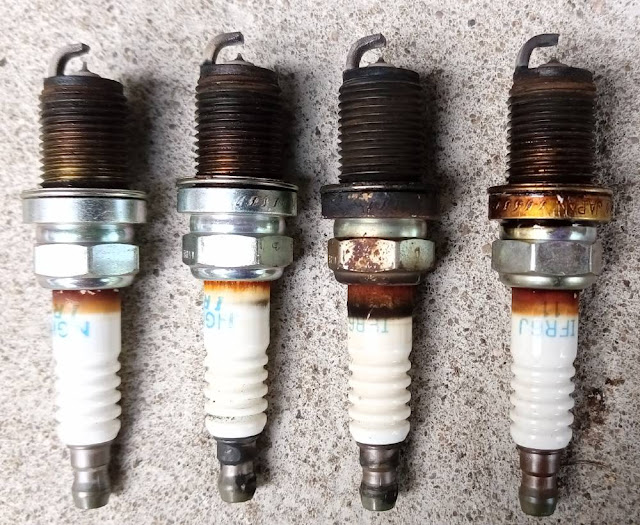Suzuki Jimny M13A Spark Plugs Replacement
I decided to replace the spark plugs on my Suzuki Jimny.
This blog page includes images and comments on fitting new plugs.
I've owned my Jimny for about 7 years and never replaced the spark plugs.
Whether they'd ever been renewed since the car's manufacture in April 2007 I don't know, but with a current mileage of just under 63K I came to the conclusion that it was probably about time.
As a Jimny owner you may possess a socket long and slim enough to reach and remove the spark plugs.
I didn't, so checked online to see what was available.
This popped up.
As you can see it's a box spanner with dual ends.
The ends are marked 5/8" (16mm) and 13/16" (21mm).
The smaller size fits the Jimny spark plug.The ends are marked 5/8" (16mm) and 13/16" (21mm).
It comes with a rubber insert which grips the plug securely during extraction.
I wanted this tool to be usable with a torque wrench.
The solution was a tad Heath Robinson but effective.

Luckily I had an M12 bolt and a couple of nuts lying around which served the purpose.
Tightening one nut on top of another achieves a locking effect.
The lower nut slots into the larger end of the box spanner while a 21mm socket fits the bolt head.
Using a torque wrench the components come together like this.
There are a couple of socket converters thrown in for good measure!
As you might expect the use of a lock nut means that this tends to work
only when tightening the plugs, but that is of course what's wanted.
Generally torque wrenches shouldn't be used to undo things in any case.
Depending upon the content of your toolbox I wouldn't be at all
surprised if you have a better solution.
The next step was to source new plugs.
NGK IFR6J11 Iridium Spark Plugs were found to be suitable for my Jimny.
The next step was to source new plugs.
NGK IFR6J11 Iridium Spark Plugs were found to be suitable for my Jimny.
The NGK part-finder UK website also recommends the IFR6J11 plugs for a Jimny.
Early in 2021 sets of four were priced online from between £50 and £80.
Here are a few photos summarising the process of spark plug replacement.
I disconnected the negative cable at the battery.
The Suzuki Jimny 1.3 litre M13A engine cylinder head upper cover is secured by four bolts.
The extraction tool previously described removes the plugs.

Here are a few photos summarising the process of spark plug replacement.
I disconnected the negative cable at the battery.
The Suzuki Jimny 1.3 litre M13A engine cylinder head upper cover is secured by four bolts.
Arrows point to the location of bolts holding the ignition coil
assembly.
With the bolts removed the ignition coil assembly is released.
Grip the caps of the high tension cords and pull them from the spark
plugs.
The extraction tool previously described removes the plugs.

The NGK website states that IFR6J11 plugs come with a
pre-set air gap suitable for my car.
I took their word for that.
So it was just a case of slipping the new plugs into the box spanner before carefully screwing them into the engine block head.
The torque recommended for this model of Jimny is 25N-m (2.5 kg-m, 18 lb-ft).
With new plugs securely in place all that remains is to re-insert the high tension cords and bolt down the ignition coil assembly.
So it was just a case of slipping the new plugs into the box spanner before carefully screwing them into the engine block head.
The torque recommended for this model of Jimny is 25N-m (2.5 kg-m, 18 lb-ft).
With new plugs securely in place all that remains is to re-insert the high tension cords and bolt down the ignition coil assembly.
Replace the upper block cover and attach the battery cable.
Start the engine... and breathe a sigh of relief!
There's information online about
reading spark plugs
and explaining how (depending upon your level of expertise)
this provides an insight into the performance of an engine.
As you'll see the firing end of all plugs removed from my
Jimny are of a uniform grey coloration which I believe
indicates they have been more or less functioning
satisfactorily.
There's a brown 'corona stain' on the insulator where it meets
the metal shell of each plug but this we are assured is not a
cause for concern and is not a result of gas leakage.
There are also dark deposits around the plug shell adjacent to
the sealing washer in the two plugs to the right of the
image.
I'm not going to hazard a guess as to what that means, but those plugs were noticeably easier to remove.
I'm not going to hazard a guess as to what that means, but those plugs were noticeably easier to remove.
So that's it.
Any comments or recommendations about the process or the choice of spark plugs are welcome.
Any comments or recommendations about the process or the choice of spark plugs are welcome.










Comments